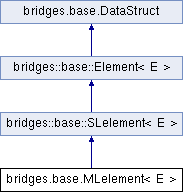|
Bridges-Java-2.3.3
2.3.3
Bridges(JavaAPI)
|
|
Bridges-Java-2.3.3
2.3.3
Bridges(JavaAPI)
|
This class can be used to instantiate Multi-list Elements. More...

Protected Member Functions | |
| void | getListElements (Vector< Element< E >> nodes) |
 Protected Member Functions inherited from bridges.base.SLelement< E > Protected Member Functions inherited from bridges.base.SLelement< E > | |
| void | getListElements (Vector< Element< E >> nodes) |
 Protected Member Functions inherited from bridges.base.Element< E > Protected Member Functions inherited from bridges.base.Element< E > | |
| void | setLinkVisualizer (Element< E > el) |
| void | removeLinkVisualizer (Element< E > el) |
| void | validateVal (E value) |
Protected Attributes | |
| MLelement< E > | sub_list = null |
 Protected Attributes inherited from bridges.base.SLelement< E > Protected Attributes inherited from bridges.base.SLelement< E > | |
| SLelement< E > | next = null |
 Protected Attributes inherited from bridges.base.DataStruct Protected Attributes inherited from bridges.base.DataStruct | |
| String | QUOTE = "\"" |
This class can be used to instantiate Multi-list Elements.
This class extends SLelement (singly linked list element) to build multi-lists; Multilist elements contain a tag that indicates if the element is a sublist or not; If the element points to a sublist, then the sublist field is the beginning of this sublist. If not, the data field contains the user specified data item and list continues (getNext()/setNext()). As in singly linked elements, the next pointer points to the following list element of the list or sublist.
Multi-list elements contain a visualizer (ElementVisualizer) object for setting visual attributes (color, shape, opacity, size), necessary for displaying them in a web browser.
Elements also have a LinkVisualizer object, that is used when they are linked to another element, appropriate for setting link attributes, for instance, between the current element and its next element. In this case, the link in question is that which connects the element to the following elements; a similar logic follows for sublists.
| <E> | The generic parameter object that is part of this element, representing either application specific data, or a pointer to a sublist. |
| bridges.base.MLelement< E >.MLelement | ( | ) |
This constructor creates an SLelement object and sets the next pointer to null
| bridges.base.MLelement< E >.MLelement | ( | String | label, |
| E | e | ||
| ) |
| bridges.base.MLelement< E >.MLelement | ( | E | e, |
| MLelement< E > | next | ||
| ) |
Creates a new element with value "e" and sets the next pointer to the SLelement referenced by the "next" argument
| e | the generic object that this element will hold |
| next | the element that should be assigned to the next pointer |
| bridges.base.MLelement< E >.MLelement | ( | MLelement< E > | sublist, |
| MLelement< E > | next | ||
| ) |
| String bridges.base.MLelement< E >.getDataStructType | ( | ) |
This method gets the data structure type
| String bridges.base.MLelement< E >.getDataStructureRepresentation | ( | ) |
|
protected |
| MLelement<E> bridges.base.MLelement< E >.getNext | ( | ) |
Retrieves the element following this element
| MLelement bridges.base.MLelement< E >.getSubList | ( | ) |
Gets the sublist at this node, if it exists
| boolean bridges.base.MLelement< E >.getTag | ( | ) |
Gets the tag of the element.
| void bridges.base.MLelement< E >.setSubList | ( | MLelement< E > | sl | ) |
| void bridges.base.MLelement< E >.setTag | ( | boolean | t | ) |
Sets the tag of the element.
| boolean | t |
|
protected |
 1.8.10
1.8.10